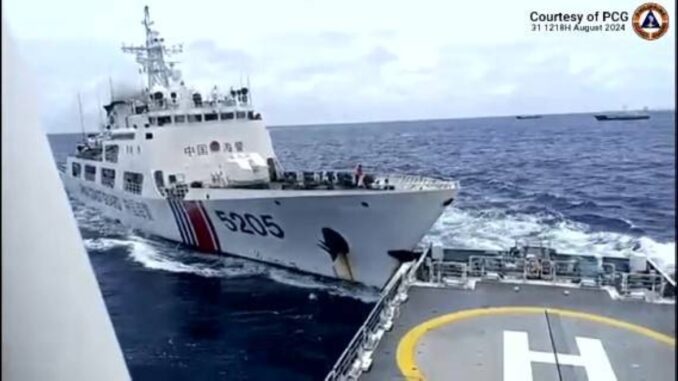
(UPDATES) A CHINA Coast Guard (CCG) vessel and a Philippine Coast Guard (PCG) ship collided on Saturday off Escoda (Sabina) Shoal in the West Philippine Sea.
In separate statements, China and the Philippines blamed each other for the collision.
In a media briefing, PCG spokesman Commo. Jay Tarriela said a CCG vessel “deliberately rammed and collided” with BRP Teresa Magbanua (MRRV-9701) three times, even though there was no provocation from the PCG ship.
‘DANGEROUS’ A Chinese Coast Guard ship rams into the BRP Teresa Magbanua, a Filipino civilian ship stationed at the Escoda (Sabina) Shoal in the West Philippine Sea, on Aug. 31, 2024. National Task Force for the West Philippine Sea spokesman Jay Tarriela said the ‘dangerous and intentional maneuver’ by the CCG ship was the fifth incident this month. There were no reported injured personnel. VIDEO COURTESY OF THE NATIONAL TASK FORCE-WEST PHILIPPINE SEA
Tarriela said at about 8:50 a.m., the BRP Teresa Magbanua heaved in its anchor with the intention of loitering around Escoda Shoal, where it has been deployed since April 15.
He said that upon noticing the movement of the PCG ship, more CCG and Chinese maritime militia vessels started to surround the Philippine vessel.
In a video presentation, Tarriela said that based on a drone shot, People’s Liberation Army (PLA) Navy Tugboats 175 and 185 and two CCG vessels, 4303 and 3104, were initially sighted in the area.
“And then, what happened next is that one of the Chinese coast guard vessels, upon learning that we’re going to be heaving in our anchor, they blew their horn, and then, all of a sudden, there was another CCG vessel (5205) that was seen approaching and getting near MRRV-9701,” he said.
Tarriela said it was CCG 5205 that carried out a “dangerous maneuver resulting in it directly ramming the port bow of MRRV-9701.
“Obviously, the Chinese coast guard vessel 5202 ignored collision regulation because of such action,” he said.
At around 12:07 p.m., Tarriela said the same CCG ship turned around and “directly and intentionally” rammed MRRV-9701 on its starboard quarter.
A few minutes later, it carried out another dangerous maneuver and rammed the port bow of Teresa Magbanua, he said.
“It is important for us to take note that this ramming happened despite our unprovoked action and presence in Escoda Shoal,” said Tarriela.
The incident resulted in damage to the bridge wing and the freeboard of BRP Magbanua, he said.
“There is also a hole that was a result of the direct ramming conducted by the CCG ship,” said Tarriela.
As of 3 p.m., BRP Teresa Magbanua dropped its anchor located inside Escoda Shoal.
Tarriela said according to PCG commandant Adm. Ronnie Gil Gavan, no personnel from the BRP Teresa Magbanua were injured.
They still have not received the details of the damages sustained by the PCG ship.
“It will still be evaluated. [Admiral Gavan] has already mentioned that there is a need for us to send our team to evaluate and to ensure the seaworthiness of BRP Teresa Magbanua despite the damage that she incurred as a result of the direct ramming by the China Coast Guard,” he said.
He said this is the fifth harassment that the PCG has experienced since August 8.
Meanwhile, in a statement, the CCG blamed the collision on the Philippine ship, which it said “acted in an unprofessional and dangerous manner.”
The CCG said one of its ships, 5205, “took measures such as shouting warnings and following up with the ship in accordance with the law and regulations.”
“The responsibility lies entirely with the Philippines. We once again warn the Philippines to face reality, give up illusions, and immediately withdraw on its own. This is the only correct way,” the CCG said.
China has been urging the Philippines to withdraw one of its ships in Escoda Shoal, where it has weighed anchor for several months now.
“Do not misjudge the situation, create hot spots, or escalate the situation; otherwise, all the consequences caused by this will be borne by the Philippines,” the CCG warned.
China reiterated that it had indisputable sovereignty over the Spratly Islands, which it calls Nansha Islands, including Escoda, which it calls Xianbin Reef, and its surrounding waters.
The CCG said it would take necessary measures to “resolutely thwart all infringing acts of provoking trouble and causing trouble at multiple points, and resolutely safeguard the country’s territorial sovereignty and maritime rights and interests.”
China claims almost all of the economically vital waterway despite competing claims from other countries and an international court ruling that its assertion has no legal basis.
Escoda Shoal is located 140 kilometers west of Palawan and about 1,200 kilometers from Hainan Island, the nearest major Chinese landmass.
Philippine and Chinese vessels collided at least twice this month near Sabina, which analysts say Beijing is seeking to further encroach upon, moving deeper into Manila’s exclusive economic zone and normalizing Chinese control of the area.
The discovery this year of piles of crushed coral at the shoal ignited suspicion in Manila that Beijing was planning to build another permanent base there, which would be its closest outpost to the Philippine archipelago.
Recent clashes between Philippine and Chinese vessels have also taken place around Ayungin (Second Thomas) Shoal.
A Filipino sailor lost a thumb in a clash there in June when Chinese coast guard members wielding knives, sticks and an axe foiled a Philippine Navy attempt to resupply a small garrison.
Escoda Shoal is also the rendezvous point for Philippine resupply missions to the garrison on Ayungin Shoal.
The repeated confrontations prompted Manila to brand Beijing the “biggest disruptor” to peace in Southeast Asia at a defense conference this month.
A maritime expert on Saturday said the Philippines must not get easily swayed by China’s new tactic of escalating tensions in Escoda Shoal and should continue patrolling the entire West Philippine Sea.
Speaking at the Saturday news forum in Quezon City, University of the Philippines Institute for Maritime Affairs and Law of the Sea Director Jay Batongbacal said that China was merely distracting the Philippines by trying to make Escoda Shoal the new “flash point” for the two countries’ maritime conflict.
“We should not be distracted by that because what we should be looking at is the totality of China’s occupation and these kinds of tactics,” he said.
Batongbacal said China’s aggressive acts in Scarborough and Ayungin Shoals would continue, but the Philippines should not focus on them at all times.
“Let’s remember, China’s intention is to occupy the entire South China Sea, including the West Philippine Sea. In order for them to occupy that, they need to be able to show the constant presence of their patrol, especially their armed forces and law enforcement,” he said
“They will definitely continue that. They will occupy it until the Philippines surrenders,” Batongbacal added.
Batongbacal also said that the Philippines is still showing China that it can still defend its own territory, and will not ask for an escort from the United States nor from any other foreign country when it does its missions to the West Philippine Sea.
“For us, of course, the solution is to show that we are not someone that you can ignore, that you can just trample on. Show them that we can fight. We can still fight, and it is important that we show them that when we fight, we are not alone; there are many who will help us,” he said when asked why the Philippines has not yet requested an escort from the US amid the threatening maneuvers of the China Coast Guard against Philippine vessels in the West Philippine Sea.
“That’s why it’s important, I think, for us that invoking our alliance with other countries should be a last resort, not first recourse,” he added.
Reports said the US had offered to escort the Philippines’ resupply missions following Beijing’s intensifying efforts to block them.
But Armed Forces chief Romeo Brawner Jr. said the Philippines would not take up the offer just yet.
“We’re happy that the US has given us a range of options, including that of joining or escorting us for the RoRes (rotation and resupply missions),” Brawner told a news conference after meeting with US Indo-Pacific commander Adm. Samuel Paparo in Baguio City.
Meanwhile, the Hague-based Permanent Court of Arbitration (PCA) is exploring the possibility of collaborating with the Supreme Court to conduct PCA proceedings in the Philippines.
PCA Secretary-General Marcin Czepelak raised this potential partnership during a courtesy visit to Chief Justice Alexander Gesmundo at the Supreme Court on Friday, the Supreme Court Public Information Office reported on Saturday.
Czepelak said this could come through a host country agreement where PCA can hold hearings in facilities provided by the Supreme Court, a suggestion that the chief magistrate said the Court could look into.
During the same meeting, the Philippine Ambassador to the Netherlands J. Eduardo Malaya, said that on August 28, the PCA signed a cooperation agreement with the Philippine Dispute Resolution Center Inc. (PDRCI) for the use of its facilities.
This means that the PCA can conduct hearings in accordance with PCA rules using facilities at PDRCI and that PDCRI-administered cases can also be conducted or held in PCA offices in The Hague, Singapore and Vietnam in accordance with PDRCI rules.
Established in 1899, the PCA plays a crucial role in facilitating the peaceful resolution of international legal disputes through arbitration.
On July 12, 2016, the PCA, adjudicating the Philippines’ case against China in the South China Sea, ruled overwhelmingly in favor of the Philippines, determining that major elements of China’s claim — including its nine-dash line, recent land reclamation activities, and other activities in Philippine waters — were unlawful. China reacted negatively to the ruling, maintaining it was “null and void.”
WITH AFP





Be the first to comment